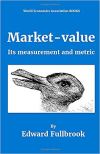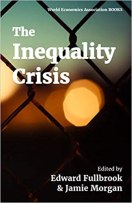Americans have no idea how unequal the distribution of income is.
from David Ruccio
Americans have no idea how unequal the distribution of income is. At the same time, they want a distribution of income that is much more equal than it currently is.
According to a new study by Sorapop Kiatpongsan and Michael I. Norton [pdf], where they looked at the estimated and ideal pay ratios of CEOs and unskilled workers, American respondents estimated the ratio of estimated incomes of CEOs to unskilled workers to be 29.6, whereas the actual ratio was about 354 (based on the fact that the average yearly compensation for CEOs of S&P 500 companies in 2012 was $12.3 million while the average worker received about $35,000). Their ideal pay ratio was only 7.
In other words, Americans think that CEOs should receive about 7 times what the average worker brings home, imagine that the actual ratio is much higher (by a factor of about four), while the actual ratio is far higher than either what they think it is (by a factor of twelve) and what the ideal would be (by a factor of over fifty).
As it turns out, Americans are not alone.
Using survey data from 40 countries (N = 55,238), we compare respondents’ estimates of the wages of people in different occupations – chief executive officers, cabinet ministers, and unskilled workers – to their ideals for what those wages should be. We show that ideal pay gaps between skilled and unskilled workers are significantly smaller than estimated pay gaps, and that there is consensus across countries, socioeconomic status, and political beliefs for ideal pay ratios. Moreover, data from 16 countries reveals that people dramatically underestimate actual pay inequality.
The task, of course, is to figure out how to close the enormous gap between the actual level of inequality and what people think the amount of inequality should be. We can start by giving workers more say in running the enterprises where they are employed.

































Factors that promote, sustain, and self-reinforce income and wealth inequality:
Fractional reserve banking that promotes indebtedness (increasing debt to wages, profits, and gov’t receipts), financialization (non-productive, inflationary financial rent seeking by the top 0.1-1%), and creating money from nothing to make money from creating money.
Favorable tax treatment of rentier income, e.g., interest, dividends, capital gains, pass-through from partnership, etc., over earned income.
Regressive taxation of working-class labor, i.e., payroll taxes totaling 15.2% per worker’s wage/salary.
Deindustrialization, financialization, and feminization (fastest-growing sectors of the economy since the 1970s-80s were gov’t, health care, education, financial services, and retail, sectors in which women make up 60-65% to 80-85% of employment) of the economy. This process coincided with women entering the labor force en masse and the increase to an unprecedented level of debt to wages and GDP since the 1980s.
Yes. The only point I would make is that women no longer pre-occupied with raising lots of kids do need working with others to keep their lives interesting.
The problem as I see it is the need to replace automated industrial work with male interests, and wages for/profits from ’employment’ with sufficient credit to enable us to look after ourselves and do the considerable amount of communal work which still needs doing. We men need to pass on technical skills through study and apprenticeships, preservation, maintenance, development and scientific work etc, and both sexes need time to compete for prizes for achievement in whatever interests them personally, be it sports, growing flowers, resolving technical problems or helping old people.
Did they specifically ask about CEOs of S&P500 or CEOs in general? Otherwise it would be quite meaningless research.